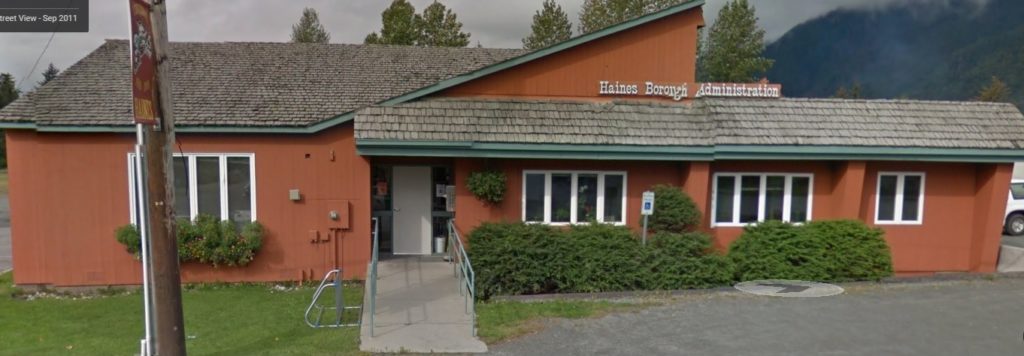
The Haines Borough Administration Building. (Google Maps)
One of the hottest topics at this week’s Haines Borough Assembly meeting wasn’t even on the agenda. Last week, manager Bill Seward announced plans to increase security measures at the borough administration building. His plan last week included a locked door and buzzer system, and a panic button under a countertop. But, at Tuesday’s meeting, after public outcry and a directive from the assembly to shut down much of the effort, Seward said his new plan will likely focus on policy and training.
Seward says staff safety was his motivation for the idea to beef up security. There have been incidents over the years, he says, and one last week that resulted in a verbal trespass order against two residents. The residents approached a borough employee, who then went to Seward to disclose the incident. Seward called the police. The subsequent investigation was inconclusive.
Last week, on Thursday morning, Seward told KHNS that he was simply interested in keeping his employees safe inside.
“We’re drawing plans to create the reception area, which will enhance our physical security of the building,” Seward said last week. “We want to construct it where it’s friendly, it’s comfortable and it’ll give us a chance to assess our customers if they’re in an angry state before we actually let them into the workplace.”
Also last week, Seward told the Chilkat Valley News that he was looking into locking doors and a buzzer system for the building. That caused some turmoil at Tuesday’s meeting from concerned residents, and assembly members.
“Installing a security screen in the public’s office of administration under these circumstances serves to illustrate the administration’s distrust of citizens, and it will further isolate citizens from their government,” said Debra Schnabel.
Leonard Dubber echoed those concerns.
“I think that this having to buzz in at the city office is just exactly the opposite message we want to send. We need to be able to slow down and listen to people a little bit, and not have to make everything ‘we’re going to win, and you’re going to lose.’”
Back at the dias, the discussion focused on the subjectivity of feeling unsafe. As in, what one perceives as a threat, might not be thought so by someone else. But Seward told the assembly, when his staff members come to him and say they feel unsafe or uneasy, he can’t ignore that. He cited a section of the United States Code regarding occupational health and safety, and hazards in the workplace.
“I have recognized given the past stories that I’ve heard, that this hazard exists,” Seward said. “So, I exercised due diligence and engaged my staff and we’re currently entertaining ideas.”
Assemblywoman Margaret Friedenauer responded, saying that members of the public can’t be considered a hazard and that Seward was misinterpreting the code.
“If there are safety issues, there are other ways to address it,” she said.
Assemblyman Ron Jackson suggested that employees, who deal with the public, need to have the skills to handle those interactions.
“They need to be able to talk to them and deescalate things when they escalate,” Jackson said. “Are there policies about what to do when they need extra help? People can be afraid in all sorts of situations. Or, not afraid.”
Assemblyman George Campbell made a motion to direct Seward to cease efforts of installing any system that would restrict access to public buildings. But, Seward warned, passing that motion would mean the assembly takes on the potential liability. He called it a “slippery slope.”
Assemblymembers Diana Lapham and Mike Case agreed that the assembly should butt out and let the manager do his job.
“I am not going to micromanage where the assembly has no purview, which is the employees,” Lapham said.
Mayor Jan Hill also weighed in before the vote, asking the assembly to let the manager work this out with borough employees. He got the message, she said.
But when Friedenauer asked Seward if he in fact did get the message, and if he would abandon his idea to turn the public building into a fortress, he didn’t say yes or no.
He said the borough employees would put their heads together, and then would discuss options with Heath Scott when he arrives to take on the role as Haines Borough Police Chief.
“The borough clerk sent out a schematic of our building to each one of the employees, they can come up and make their proposals,” Seward said, in response to Friedenauer. “We’re going to run them by the chief of police and see what his advice is, and then go from there.”
The motion to halt plans for selective entry into the administration building passed 4-2, with Lapham and Case opposed.
After the meeting, Seward said he was going to focus on policy and training for employees to deal with disgruntled residents. He said he was just throwing ideas around when he made statements about locks and buzzers, and that he was leaning toward a friendlier option anyway.









